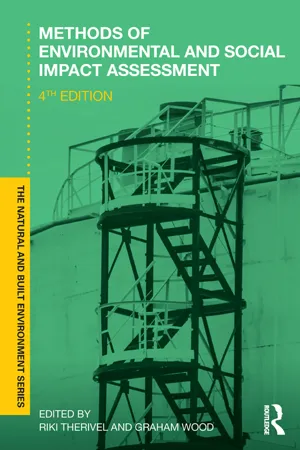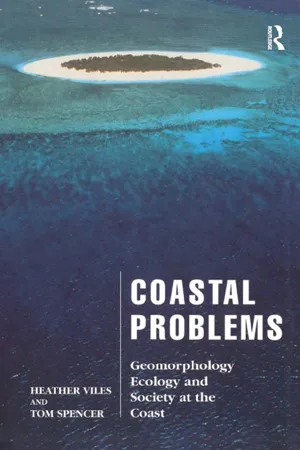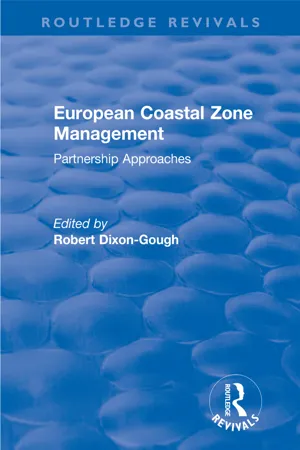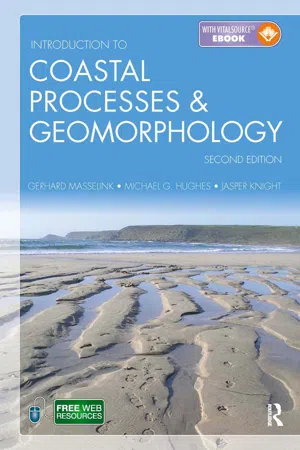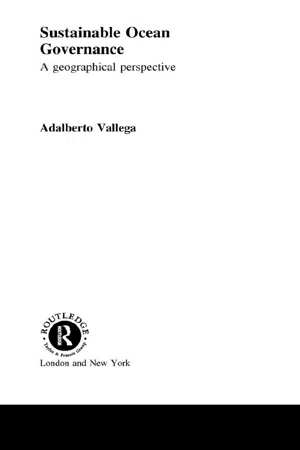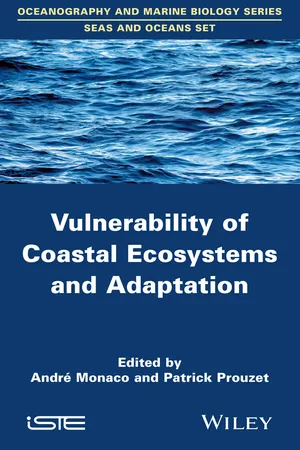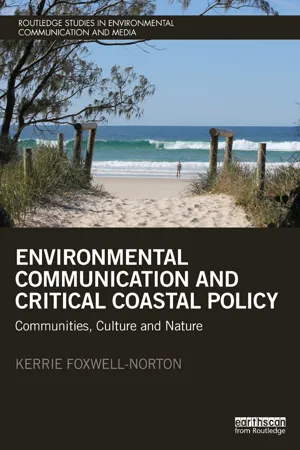Geography
Coasts Geography
Coastal geography is the study of the dynamic interface between land and sea. It encompasses the physical processes, landforms, ecosystems, and human activities that shape and are shaped by coastal environments. Key concepts include erosion, deposition, coastal landforms, sea level change, and the impact of human activities on coastal areas.
Written by Perlego with AI-assistance
Related key terms
Related key terms
1 of 4
Related key terms
1 of 3
10 Key excerpts on "Coasts Geography"
- Peter Morris, Riki Therivel, Graham Wood, Riki Therivel, Graham Wood(Authors)
- 2017(Publication Date)
- Routledge(Publisher)
An additional and pressing issue facing coastal areas is the predicted sea-level rise associated with climate change. This is particularly so in countries such as Bangladesh and the Netherlands, where wide areas are situated just above sea level. Over the period 1901 to 2010, global mean sea level rose by an average of 0.19 m, and a further likely rise of 0.26 to 0.55 m is predicted by 2100 (IPCC 2014). In England, the Environment Agency (2013) has produced sea-level rise contingencies for up to 2115 for use in flood risk planning. Similarly, the US Ocean Protection Council (2013) have provided guidance for incorporating sea-level rise projections into project planning and decision-making in California up to 2100, which range from 0.1 to 1.67 m. In addition to risks to human life, settlements and agricultural land, rising sea levels threaten the integrity of significant areas of coastal habitat. For instance, Jones et al. (2011) estimated that coastal margin habitats in the UK will decline in area by approximately 8 per cent by 2060, due to coastal erosion, sea-level rise and reduced sediment supply. Moreover, salt marshes that are ‘trapped’ between rising sea levels and fixed sea defences are being lost to coastal squeeze. Loss of salt marsh also threatens the integrity of seawalls (defending low-lying areas) that rely on their wave absorbing power (Möller et al. 2014).This chapter provides a description of key coastal landforms, processes and habitats, and summarises relevant legislation and policy. In the context of the pressures faced in the coastal zone, it sets out proposed approaches to scoping environmental investigations, and coastal ecology and geomorphological surveys and studies. It considers typical impacts that arise in the coastal zone, their sources and nature, and methods of impact prediction, as well as options for impact mitigation and the purpose of and approaches to monitoring.7.2 Definitions and concepts
7.2.1 The coastal zone
Coasts are among the most dynamic parts of the earth’s surface. The land and the sea rarely meet at a constant boundary. The shoreline migrates daily with the tide, changes seasonally, and varies over longer timescales as the coast erodes or accretes, or as sea level changes. Coastal landforms are shaped and reshaped by winds, waves and currents, which in turn vary through time.The coast everywhere is an interface between the energy of the sea and the resistance of the land. While there are bare rocky cliffs that will take the full force of a storm without apparently suffering much damage, in most places the energy is absorbed by a beach. This is sometimes a wide beach backed by dunes, or a narrow beach in front of cliffs, or a barrier beach behind which salt marshes can accumulate in a sheltered environment (see Figure 7.1 ). Left alone, coasts will change over time, either building out where sediment accumulates, or moving landward as areas are eroded and the sediment is removed offshore or along the shore.For consistency across the geomorphological and ecological disciplines, definition of the seaward and landward limits of the coast uses the concepts of the supralittoral, littoral and sublittoral- eBook - ePub
Coastal Problems
Geomorphology, Ecology and Society at the Coast
- Heather Viles, Tom Spencer(Authors)
- 2014(Publication Date)
- Routledge(Publisher)
Chapter Two HOW COASTS WORK IntroductionFrom the dramatic, precipitous cliffs of the Banks Peninsula, South Island, New Zealand to the palm-fringed, gleaming white, coral sands of a Seychelles beach there is an almost infinite variety of coastal scenery. In any one place the coastal zone consists of the same basic components (water, air, sediments, rocks and organisms), but how they are structured depends on a range of factors including geology, climate and oceanographic regime. Contemporary processes interact with landforms produced by past changes in sea level, sediment supply and process regime. Many North American and north-west European coasts, for example, show strong legacies, in terms of sea level change and recent sediment supply, from the repeated advance and retreat of large ice sheets over the last 1–2 million years.Many attempts have been made to classify and explain the diversity of coastal environments using genetic or descriptive criteria, or a mixture of the two. Thus Johnson (1919) split coasts into submergent, emergent, neutral and compound, depending on their recent history of relative sea level, Shepard (1963) divided coasts according to the relative importance of coastal and non-coastal processes, recognizing primary coasts (virtually unmodified by coastal processes) and secondary forms, and Davies (1964, 1972) split the world’s coastline up according to wave activity leading to a division into high latitude storm wave coasts, low latitude swell wave coasts and low energy coasts. Clearly all these different approaches are of value. Here we recognize the importance of variations in geological structure, sea level history and biogeography in providing contexts within which both contemporary ecological and geomorphological processes act and future environmental changes will be placed.Plate tectonics and coastal typeInman and Nordstrom (1971) produced an important classification based primarily on plate tectonics. They define three major coastal scales as shown in Table 2.1 . The controls operative at the first and second order provide a classification (tectonic and morphological) for the whole coastal zone. The controls operating at the third order help classify features within the shore zone. Coastal type at the large scale, therefore, is determined by the position of the area relative to plate margins, leading to a division of the world’s coastline into collision, trailing-edge and marginal sea coasts (Fig. 2.1 ). Collision, or active margin, coasts are typically characterized by the delivery of relatively coarse sediments from mountainous catchments to a coastal zone characterized by a narrow continental shelf and deep water not far offshore. Trailing edge, or passive margin, coasts by comparison are fed by large rivers often draining enormous drainage basins, thus contributing large volumes of fine sediments to wide, low-angle continental shelves. Most of the world’s major deltas are associated with trailing-edge coasts and they are also characterized by extensive barrier island development. Collision coasts, as in the Mediterranean and south-east Asia, often support only rocky shorelines, with poor beach or reef development, and exhibit sea level histories complicated by regional tectonic movements. These controls help provide a basis for the second order of Inman and Nordstrom’s (1971) classification (Table 2.2 - eBook - ePub
European Coastal Zone Management
Partnership Approaches
- Robert Dixon-Gough(Author)
- 2017(Publication Date)
- Routledge(Publisher)
4 Regional and international conflicts within the coastal zone. A case for partnerships and European-wide cooperation R.W. DIXON-GOUGHDefinition of the coastal zone and coastal zone management
Throughout this paper, the terms coastal zone and Coastal Zone Management are used extensively. In order to avoid confusion, these terms are defined below.The Coastal zone
The coastal zone is taken to include the rivers and tidal inlets, the terrestrial coast (sea cliffs, sand dimes, shingle structures and coastal grazing marshes), inter-tidal shores (including sandy beaches, mudflats and rocky shores) and the marine zone to the offshore limit of coastal processes, together with the plants and animals living within the zone. Geomorphological processes form the basis for the development of coastal habitats and the wildlife, which they support. These may operate over a wide geographical area and essentially provides the link between the land and the body of water.Superimposed in this is the factor of mobility, not only because the zone is dynamic but also of the many species of animals, notably migrating birds, sea mammals and fish, which are dependent upon this zone. Human impact in this zone can be equally wide-ranging and the potential scale and complexity of the interactions can be immense. For planning purposes, the zone can be defined according to the human uses and activities, which may take place there. Taken from both perspectives, the zone is defined as a combination of natural features and human activities, which may interact across the whole zone or within individual components of the zone. Recognition of this interaction is the first stage in understanding the need for an integrated approach to management of the zone. - Gerd Masselink, Michael Hughes, Jasper Knight(Authors)
- 2014(Publication Date)
- Routledge(Publisher)
CHAPTER 1COASTAL SYSTEMS
AIMSThis chapter outlines how the coastal zone can be defined and discusses the properties and characteristics of systems, highlighting the importance of sedimentary processes and concepts such as self-organisation. Consideration of systems is useful because it provides a framework by which the dynamic behaviour of geomorphological processes and landforms can be understood.1.1IntroductionThis book is about coastal processes and geomorphology. The spatial boundaries of the coastal zone as considered in this book are defined in Figure 1.1 and follow the definitions set out by Inman and Brush (1973). The upper and lower boundaries correspond to the elevational range over which coastal processes have operated during the Quaternary period, and include the coastal plain, the shoreface and the continental shelf. During the Quaternary (from 2.6 million years ago until present), sea level fluctuated over up to 135 m vertically due to expansion and contraction of ice sheets and warming and cooling of the oceans. The landward limit of the coastal system therefore includes the coastal depositional and marine erosion surfaces formed when sea level was high (at or just above its present-day position) during global warm periods. The lowest sea levels, during global cold periods, placed coastal processes close to the edge of the continental shelf. The seaward limit of the coastal system is therefore defined by the continental shelf break, which typically occurs in water depths of 100–200 m. Changes in global climate during the Quaternary markedly shifted the position of the coastal zone, changing coastal geography particularly in areas with extensive shelves (Case Study 1.1 ). Many of today’s coastal landscapes reflect their Quaternary (and older) geological inheritance, and are responding dynamically to human activity in the coastal zone and ongoing global warming. Having defined the spatial boundaries of the topic of this book, we now need to indicate the time scale we are interested in. Cowell and Thom (1994) group the time scales over which coastal processes operate into four overlapping classes (Figure 1.3- eBook - ePub
- Cynthia Metcalf, Rhonda Atkinson(Authors)
- 2017(Publication Date)
- Research & Education Association(Publisher)
CHAPTER 1 Geography Geography is the study of the Earth’s surface, including such aspects as its climate, topography, vegetation, and population.Geography is much more than just memorizing names and places and studying the physical features of the Earth. While geography requires an understanding of the Earth’s surface, it also is concerned with the distribution of living things and Earth’s features around the Earth. Geography focuses on three questions: Where? Why there? What are the consequences of it being there? Geographers look at the Earth’s physical space and investigate patterns. For example, a geographer might look at the space of your bedroom and ask several questions: How are things distributed? Why are they where they are? What processes operate in that space? How does this space relate to other nearby spaces? Geographers call this way of identifying, explaining, and predicting human and physical patterns in space and the interconnectedness of various spaces the spatial perspective . Geography views the Earth through a lens of location and space and seeks to find patterns of place or interactions between places and people. Thus, geography is the science of space and place.Branches of Geography Generally, geography can be divided into four main branches:Human Geography focuses on humans and the cultures they create relative to their space. It encompasses population geography, economics, and political geography and looks at how people’s activities relate to the environment politically, culturally, historically, and socially.Physical Geography addresses Earth’s physical environment: water (hydrosphere ), air (atmosphere ), plants and animals (biosphere ), and land (lithosphere ). Physical geographers study land formation, water, weather, and climate - eBook - ePub
Sustainable Ocean Governance
A Geographical Perspective
- Adalberto Vallega(Author)
- 2002(Publication Date)
- Routledge(Publisher)
4 the ecological and jurisdictional lines delimiting the geographical coverage of coastal management programmes were respectively presented. These elements will now be used to discuss how the coastal area may be identified. This question has two dimensions according to whether the coastal area is delimited for research or management purposes.Coastal areas for research purposes may be delimited in various ways according to the disciplinary perspective concerned. From the geomorphologic point of view, the coastal area may be defined as the belt stretching from the low tide mark (seawards) to the landward limit of the backshore embracing a space directly influenced by the interaction between the marine and atmosphere movements within the land-sea interface. Geologically, the outer edge of the continental shelf, or that of the continental margin may be regarded as the seaward boundary, whilst the landward boundaries follow watershed lines. Ecologically, the extent of ecosystems located landwards and seawards from the coastline may be considered. From the point of view of economic geography, the seawards extent of coastal facilities, and the landwards extent of coastal land uses may be regarded as lines relevant to management needs. Other points of view, such as those based on the administrative and jurisdictional imperatives, may be adopted. In all these cases, the basic question to which delimitation should respond is ‘what is the rational extent of the coastal area?’.Figure 7.1 The complexity-based approach to coastal management. Consideration of coastal ecosystems and use structure drives the design of coastal organisation.Where the coastal area is delimited for management purposes the geographical coverage is identified according to the goals and targets of relevant programmes. It is therefore useful to evaluate the criteria and approaches adopted by past management systems, as a background against which critically to present and discuss the requirements for sustainable coastal development. As can be seen from the list following Table 7.1 - eBook - ePub
Environmental Management in Practice: Vol 3
Managing the Ecosystem
- Paul Compton, Dimitri Devuyst, Luc Hens, Bhaskar Nath(Authors)
- 2013(Publication Date)
- Routledge(Publisher)
1
COASTAL ENVIRONMENTS
Julian D.Orford
SUMMARY
The basic ecological principle embodied in the study of physical environment systems is that of continuity of energy and mass among constituent parts of the system. In a coastal context this principle is recognised in the sediment transport linkages that exist between coastal environments. Changes in beach sediment transport rate control the rate at which coasts may alter. The spatial control on sediment continuity defines the structure of coastal cells which offer the ecologically sustainable basis for coastal management programmes. Coastal erosion is only a problem where human activity impinges upon the normal erosional processes of coastal evolution. Coastal protection as a response to erosion is the historical basis for coastal management programmes and is still the mainstay of modern coastal zone management. Most human coastal intervention makes it difficult to base management approaches on ecological principles without considerable adaptation or cost. In this chapter some examples of management policies are examined for evidence of ecological principles at work. Not surprisingly, economic and cultural principles appear still to be the controlling aspects of coastal management policy. - eBook - ePub
Greening the College Curriculum
A Guide To Environmental Teaching In The Liberal Arts
- Jonathan Collett, Stephen Karakashian, Jonathan Collett, Stephen Karakashian(Authors)
- 2013(Publication Date)
- Island Press(Publisher)
The approach of geographers to the study of environmental change emphasizes spatial pattern, a large scale of inquiry (over space and time), and the integration of social and natural sciences. Geographers typically conduct research at the level of landscape or region; for example, considering land use patterns and their impact on vegetation in a drainage basin or watershed. Recently, geographers have begun working at much broader scales. Such a study is under way in Mexico, where Liverman (1990) is investigating the capacity of small-scale farmers to cope with climatic change over several decades. Research elsewhere documents local adaptation in land management upon elevated exposure to storms, oil spills, flooding, and other forms of environmental risk (Kates and Burton 1986).While geography as a discipline encompasses a broad realm of inquiry, geographers as individuals tend to specialize in either human or physical studies, often borrowing methods of analysis from other disciplines. Geographers traditionally break the study of human transformation of the biosphere into four fields: (1) regional studies, (2) people—environ-ment studies, (3) environmental processes and resources, and (4) spatial analysis.Regional Studies
Geographers working in this tradition address conservation issues relevant to a particular place. A regional focus allows students to understand how the physical characteristics and social history of a place have led to a unique land use system. Students may draw on this insight to evaluate the sustainability of a land use system and to predict how changing external and internal factors may result in the transformation or degradation of a landscape (Leighly 1969). For example, many Latin Americanist geographers examine how deforestation in the Amazon is driven by distinctive regional characteristics such as land tenure patterns, demographic features, government policies, and agricultural and economic systems (Hecht and Cockburn 1989; Smith 1982).People—Environment Studies
Within this broad focus, geographers explore the relationship between society and nature in terms of causes and consequences. The justification for environmental conservation is likely to vary dramatically according to a society’s own view of its relationship with nature. Ancient writers such as Hippocrates, Ptolemy, and Strabo expressed a profound desire to define the human role in the natural world. Since then, many philosophies have developed, ranging from the Christian doctrine of defining man as master of nature (Glacken 1956) (see Chapter 11, Religion), to Romantic/Arcadian ideas of humanity in harmony with nature (O’Riordan 1981) (see Chapter 7, Literature), to deterministic theories akin to social Darwinism that individual and social characteristics are formed by the physical environment (Semple 1911), to notions that human choice is influenced primarily by cultural and historical factors (Lewthwaite 1966). (These latter viewpoints are discussed fully in Chapter 2, Anthropology.) Accordingly, the aim of conservation will vary in terms of what type of human intervention in ecosystems a given society considers desirable. - André Monaco, Patrick Prouzet(Authors)
- 2014(Publication Date)
- Wiley-ISTE(Publisher)
With various uses of a fragile and highly dynamic space and with growing pressure, competing human activities of all types arise. Can we regulate without prohibiting and, if prohibiting is unavoidable, can we do so with the consent of all the stakeholder groups? In other words, can we protect coastal human settlements and the coastal environments from human covetousness? It is a major challenge that requires an integrated management approach of coastal zones.5.2. Coastal dynamics
The more settlements have moved to coastal areas, the more sensitive these areas have become to changes in the coastline. While the postglacial sea level rise was coming to an end, the residents of the Gulf of Morbihan had to move their settlements further inland, which we are reminded of by a few megaliths immersed by a several meters depth. Nowadays, the same observations are made everywhere, especially as the exposed settlements are numerous and as the coast had to be barricaded by flood defense walls to protect its residents from the waves. Coastal erosion is a natural process: a cliff is a perfect vestige of erosion, and this movement is irreversible. It can be seen each year between Criel-sur-Mer and the Somme Bay, when comparing it with photographs taken successively since the end of the 19th Century that, roll after roll, dozens of meters have fallen into the sea. However, in spite of this observation, things are more complicated as they have developed within a real system that should be explained.5.2.1. The morphogenic coastal system
In this system, five factors play a role [MIO 09] (Figure 5.1 ).Figure 5.1.This model links together the interactions involved on the basis of five factors, climate (in all the different meanings of the term), sea level, coastal dynamics as related to climate and the sediment balance and partly related to coastal dynamics and partly to human actionsThe driver of the system is the climate, and it can be interpreted in the wider sense at all the scales, both temporal and spatial. It includes the weather as much as the climatic zone; the recent time-frame (week, year, decade, etc.) as much as the great climatic oscillations that have marked the Quaternary era and of which the coasts still bear the mark (marine sediments reveal the movements of the sea; masses of sediments washed off from the continents and sorted, reworked during marine transgressions). On the coasts, it becomes clear that the first effect of the climate is the wind, sometimes acting through the sea (swells, waves, etc.), and on the coast itself, through the deflation of sandy shores. The first dunes in line manifest the wind by their shapes. Surges gather sediments and wash them laterally (coastal drift) or transversally onto the “profile” of the beaches.- eBook - ePub
Environmental Communication and Critical Coastal Policy
Communities, Culture and Nature
- Kerrie Foxwell-Norton(Author)
- 2017(Publication Date)
- Routledge(Publisher)
This chapter begins by examining the relationship between culture and nature, and the complexity of meanings that people bring to their encounters with the environment – in this case, the coast. Evident in the introductory quotes here are different concepts of the coast (although not necessarily mutually exclusive) that point to fundamentally different ideas of this relationship between members of the same Cabarita Beach/Bogangar coastal community. These impressions of the coast provide some insight into the discourses that support their coastal truths – and a subsequent opportunity to explore the more critical dimensions of the currency and legitimacy of these ideas in the public sphere. How is it that some ideas of the coast dominate while others remain on the margins, and with what consequences for community participation in local environmental issues? Investigation of these too often obvious truths that define the coast – the credible and the uncredible – and their expression in coastal policy alongside their communication in the public sphere constitute the core discussion of this book.The ideas themselves are, in part, indicative of the deeper philosophical debate about the division (if any) and complexities between nature and culture (Eagleton 2000; Giblett 2011; Soper 1995) and the subsequent divisions between humanities and social sciences, and the science, technology, engineering and maths disciplines – or what Beck (1992) has identified simply as ‘social thinking’ and ‘science thinking’. This perennial debate, much of which has occurred within the humanities and social sciences, continues to define the terrain of humanity’s possible responses to environmental issues, from the global issues of climate change to the local issues of coastal development. In this approach, controversy and debate in the coastal zone especially, and environments more broadly, come to be about different frameworks for understanding the coast – or an expression of the diverse philosophical distinctions between the dialectics of nature and culture. These dialectics fundamentally empower or circumscribe ideas of ‘participation’ in coastal management for communities, broadly defined. They act to prioritize and legitimize some definitions of our relations with the natural coastal environment. At the forefront of this discussion is a nuanced investigation of environmentally sustainable development (ESD) – the darling of coastal policy everywhere – and its culture and dialectic.
Index pages curate the most relevant extracts from our library of academic textbooks. They’ve been created using an in-house natural language model (NLM), each adding context and meaning to key research topics.
Explore more topic indexes
Explore more topic indexes
1 of 6
Explore more topic indexes
1 of 4
